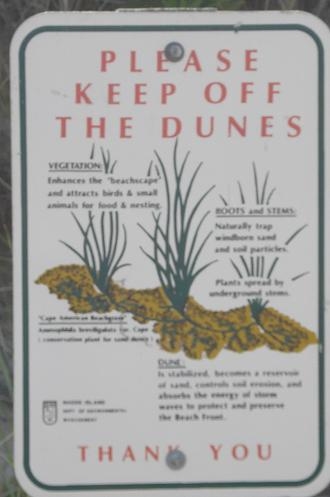RI - Roger Wheeler Sand Dunes EarthCache
RI - Roger Wheeler Sand Dunes
-
Difficulty:
-

-
Terrain:
-

Size:  (other)
(other)
Please note Use of geocaching.com services is subject to the terms and conditions
in our disclaimer.
Roger Wheeler Beach in Narragansett, Rhode Island has several sand dunes. This Earthcache provides an educational background in how they were formed and takes you on an exploration of them. Note that there is a parking fee during summer months. Also please STAY OFF OF THE DUNES as you do not need to disturb them to collect the information.
What Is a Sand Dune
A sand dune is a mound of sand that lies behind the part of the beach affected by tides. They are formed over several years when windblown sand is trapped by beach grass or other stationary objects. The grasses anchor the dunes with their roots, holding them in place, while their leaves trap sand promoting dune expansion. Without vegetation, wind and waves regularly change the form and location of dunes. Note that dunes are not permanent structures.
Roger Wheeler Sand Dune

How Are Sand Dunes Formed?
For dunes to form, three key things are needed. The first is sand. The second is to set the sand in motion. Wind carries fine grains of sand and bounces heavier sand grains along. And while wind isn't strong enough to move really heavy grains of sand, bouncing sand is enough to push the heaviest grains forward. Finally, an obstacle such as a plant is needed to block the wind and cause the sand to pile up. Once sand piles up dunes can form.
Sand Dune Information

Sand dunes have an ever-changing life cycle and are in constant motion. Beaches and foredunes (those closest to the beach) are in a constant state of change in response to wind , sea levels, and supply of sand. Erosion and rebuilding are the results of this readjustment. For example, a beach may change form after a storm. During a storm the beach may be eroded and the face of the foredune severely cut back (scarped) as a response to the greater waves imposed upon it. These changes can be rapid – a matter of hours, but the recovery of the beach may be much more gradual – days or weeks, as sand is again returned to the beach and blown up against the eroded dune face. In some cases erosion or accretion is permanent; but more often it is just temporary changes and part of a natural cycle of dune erosion, rebuilding and stabilization. However, until the dune is completely veiled and stabilized by plant cover, sand may be borne away by the wind.
Sand Dunes Serve Many Purposes
1. Sand dunes provide sand storage and supply for adjacent beaches.
2. Sand dunes protect inland areas from storm surges, hurricanes, flood-water, and wind and wave action that can damage property. Because they are high and in between the water and inland properties they provide a natural barrier.
3. Sand dunes support an array of organisms by providing nesting habitat for coastal bird species including migratory birds.
4. Sand dunes are also habitat for coastal plants.
Plants and Flowers Living in the Dune

Assignment
Collect information on the sand dunes at Roger Wheeler Beach. You can see sand dunes from the main coordinates of this cache or go to the larger dune noted as a Waypoint. Note that you do not need to climb on or disturb the dunes to gather this information
1. Estimate the distance that the sand traveled from the edge of the ocean
2. Estimate the height of the sand dune
3. Identify the items that are holding the dune in place
4. Send me an e-mail with the answers for 1-3.
5. In your log note any identified animals or interesting features of the sand dune
6. Optional – Post a picture at the sand dune
Additional Hints
(No hints available.)